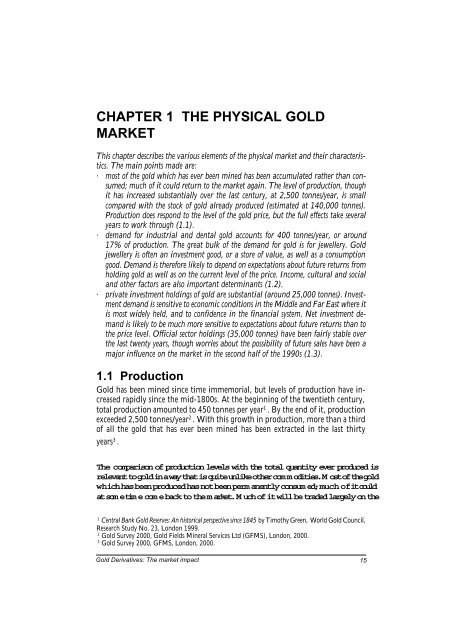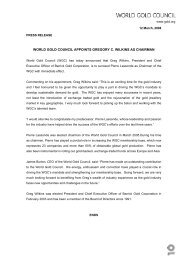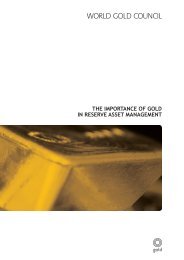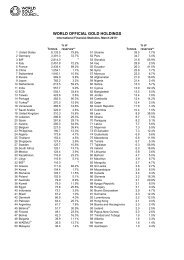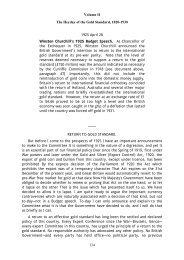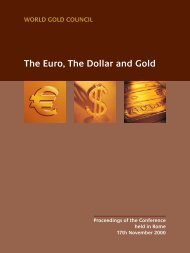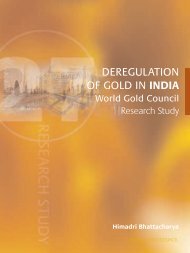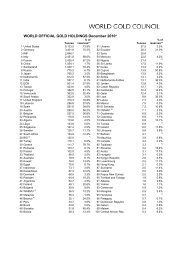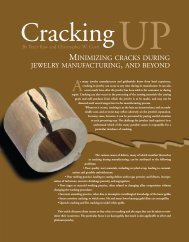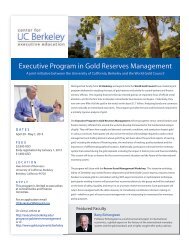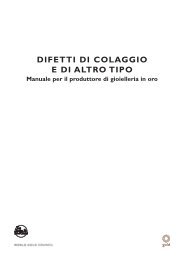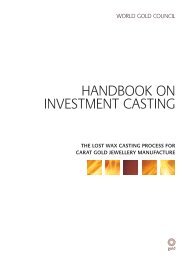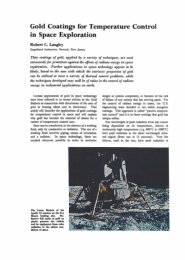Gold Derivatives: Gold Derivatives: - World Gold Council
Gold Derivatives: Gold Derivatives: - World Gold Council
Gold Derivatives: Gold Derivatives: - World Gold Council
You also want an ePaper? Increase the reach of your titles
YUMPU automatically turns print PDFs into web optimized ePapers that Google loves.
CHAPTER 1 THE PHYSICAL GOLD<br />
MARKET<br />
This chapter describes the various elements of the physical market and their characteristics.<br />
The main points made are:<br />
· most of the gold which has ever been mined has been accumulated rather than consumed;<br />
much of it could return to the market again. The level of production, though<br />
it has increased substantially over the last century, at 2,500 tonnes/year, is small<br />
compared with the stock of gold already produced (estimated at 140,000 tonnes).<br />
Production does respond to the level of the gold price, but the full effects take several<br />
years to work through (1.1).<br />
· demand for industrial and dental gold accounts for 400 tonnes/year, or around<br />
17% of production. The great bulk of the demand for gold is for jewellery. <strong>Gold</strong><br />
jewellery is often an investment good, or a store of value, as well as a consumption<br />
good. Demand is therefore likely to depend on expectations about future returns from<br />
holding gold as well as on the current level of the price. Income, cultural and social<br />
and other factors are also important determinants (1.2).<br />
· private investment holdings of gold are substantial (around 25,000 tonnes). Investment<br />
demand is sensitive to economic conditions in the Middle and Far East where it<br />
is most widely held, and to confidence in the financial system. Net investment demand<br />
is likely to be much more sensitive to expectations about future returns than to<br />
the price level. Official sector holdings (35,000 tonnes) have been fairly stable over<br />
the last twenty years, though worries about the possibility of future sales have been a<br />
major influence on the market in the second half of the 1990s (1.3).<br />
1.1 Production<br />
<strong>Gold</strong> has been mined since time immemorial, but levels of production have increased<br />
rapidly since the mid-1800s. At the beginning of the twentieth century,<br />
total production amounted to 450 tonnes per year 1 . By the end of it, production<br />
exceeded 2,500 tonnes/year 2 . With this growth in production, more than a third<br />
of all the gold that has ever been mined has been extracted in the last thirty<br />
years 3 .<br />
The comparison of production levels with the total quantity ever produced is<br />
relevant to gold in a way that is quite unlike other commodities. Most of the gold<br />
which has been produced has not been permanently consumed; much of it could<br />
at some time come back to the market. Much of it will be traded largely on the<br />
1<br />
Central Bank <strong>Gold</strong> Reserves: An historical perspective since 1845 by Timothy Green, <strong>World</strong> <strong>Gold</strong> <strong>Council</strong>,<br />
Research Study No. 23, London 1999.<br />
2<br />
<strong>Gold</strong> Survey 2000, <strong>Gold</strong> Fields Mineral Services Ltd (GFMS), London, 2000.<br />
3<br />
<strong>Gold</strong> Survey 2000, GFMS, London, 2000.<br />
<strong>Gold</strong> <strong>Derivatives</strong>: The market impact 15


